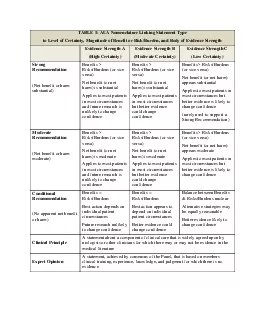

to Level of Certainty Magnitude of Benefit or RiskBurden and Body of Evidence StrengthEvidence Strength AHigh CertaintyEvidence Strength BModerate CertaintyEvidence Strength CLow CertaintyStrong Reco ID: 883996
Download Pdf The PPT/PDF document "TABLE 1 AUA Nomenclature Linking Stateme..." is the property of its rightful owner. Permission is granted to download and print the materials on this web site for personal, non-commercial use only, and to display it on your personal computer provided you do not modify the materials and that you retain all copyright notices contained in the materials. By downloading content from our website, you accept the terms of this agreement.
1 TABLE 1: AUA Nomenclature Linking Statem
TABLE 1: AUA Nomenclature Linking Statement Type to Level of Certainty, Magnitude of Benefit or Risk/Burden, and Body of Evidence Strength Evidence Strength A (High Certainty) Evidence Strength B (Moderate Certainty) Evidence Strength C (Low Certainty) Strong Recommendation (Net benefit or harm substantial) Benefits� Risks/Burdens (or vice versa) Net benefit (or net harm) is substantial Applies to most patients in most circumstances and future research is unlikely to change confidence Benefits� Risks/Burdens (or vice versa) Net benefit (or net harm) is substantial Applies to most patients in most circumstances but better evidence could change confidence Benefits� Risks/Burdens (or vice versa) Net benefit (or net harm) appears substantial Applie s to most patients in most circumstances but better evidence is likely to change confidence (rarely used to support a Strong Recommendation) Moderate Recommendation (Net benefit or harm moderate) Benefits� Risks/Burdens (or vice versa) Net benefit (or net harm) is moderate Applies to most patients in most circumstances and future research is unlikely to change confidence Benefits� Risks/Burdens (or vice versa) Net benefit (or net harm) is moderate Applies to most patients in most circumstances but bett er evidence could change confidence Benefits� Risks/Burdens (or vice versa) Net benefit (or net harm) appears moderate Applies to most patients in most circumstances but better evidence is likely to change confidence Conditional Recommendation (No appar ent net benefit or harm) Benefits = Risks/Burdens Best action depends on individual patient circumstances Future research unlikely to change confidence Benefits = Risks/Burdens Best action appears to depend on individual patient circumstances Better evid ence could change confidence Balance between Benefits & Risks/Burdens unclear Alternative strategies may be equally reasonable Better evidence likely to change confidence Clinical Principle A statement about a component of clinical care that is widely agreed upon by urologists or other clinicians for which there may or may not be evidence in the medical literature Expert Opinion A statement, achieved by consensus of the Panel, that is based on members clinical training, experience, knowledge, and judgm ent for which there is no evidence